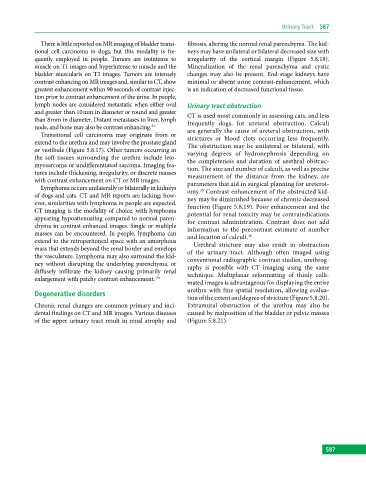Page 597 - Atlas of Small Animal CT and MRI
P. 597
Urinary Tract 587
There is little reported on MR imaging of bladder transi- fibrosis, altering the normal renal parenchyma. The kid-
tional cell carcinoma in dogs, but this modality is fre- neys may have unilateral or bilateral decreased size with
quently employed in people. Tumors are isointense to irregularity of the cortical margin (Figure 5.8.18).
muscle on T1 images and hyperintense to muscle and the Mineralization of the renal parenchyma and cystic
bladder muscularis on T2 images. Tumors are intensely changes may also be present. End‐stage kidneys have
contrast enhancing on MR images and, similar to CT, show minimal or absent urine contrast‐enhancement, which
greatest enhancement within 90 seconds of contrast injec- is an indication of decreased functional tissue.
tion prior to contrast enhancement of the urine. In people,
lymph nodes are considered metastatic when either oval Urinary tract obstruction
and greater than 10 mm in diameter or round and greater CT is used most commonly in assessing cats, and less
than 8 mm in diameter. Distant metastases to liver, lymph frequently dogs, for ureteral obstruction. Calculi
node, and bone may also be contrast enhancing. 33 are generally the cause of ureteral obstruction, with
Transitional cell carcinoma may originate from or strictures or blood clots occurring less frequently.
extend to the urethra and may involve the prostate gland The obstruction may be unilateral or bilateral, with
or vestibule (Figure 5.8.17). Other tumors occurring in varying degrees of hydronephrosis depending on
the soft tissues surrounding the urethra include leio- the completeness and duration of urethral obstruc-
myosarcoma or undifferentiated sarcoma. Imaging fea- tion. The size and number of calculi, as well as precise
tures include thickening, irregularity, or discrete masses measurement of the distance from the kidney, are
with contrast enhancement on CT or MR images. parameters that aid in surgical planning for ureterot-
Lymphoma occurs unilaterally or bilaterally in kidneys 35
of dogs and cats. CT and MR reports are lacking; how- omy. Contrast enhancement of the obstructed kid-
ney may be diminished because of chronic decreased
ever, similarities with lymphoma in people are expected. function (Figure 5.8.19). Poor enhancement and the
CT imaging is the modality of choice, with lymphoma potential for renal toxicity may be contraindications
appearing hypoattenuating compared to normal paren- for contrast administration. Contrast does not add
chyma in contrast‐enhanced images. Single or multiple information to the precontrast estimate of number
masses can be encountered. In people, lymphoma can and location of calculi. 36
extend to the retroperitoneal space with an amorphous Urethral stricture may also result in obstruction
mass that extends beyond the renal border and envelops of the urinary tract. Although often imaged using
the vasculature. Lymphoma may also surround the kid- conventional radiographic contrast studies, urethrog-
ney without disrupting the underlying parenchyma, or raphy is possible with CT imaging using the same
diffusely infiltrate the kidney causing primarily renal technique. Multiplanar reformatting of thinly colli-
enlargement with patchy contrast enhancement. 34
mated images is advantageous for displaying the entire
urethra with fine spatial resolution, allowing evalua-
Degenerative disorders
tion of the extent and degree of stricture (Figure 5.8.20).
Chronic renal changes are common primary and inci- Extramural obstruction of the urethra may also be
dental findings on CT and MR images. Various diseases caused by malposition of the bladder or pelvic masses
of the upper urinary tract result in renal atrophy and (Figure 5.8.21).
587

